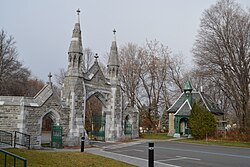
Back Friedhof Mont-Royal German Cementerio Mount Royal Spanish Cimetière Mont-Royal French Цвинтар Мон-Руаяль Ukrainian
| Mount Royal Cemetery | |
|---|---|
Cimetière Mont-Royal | |
 The cemetery's gate in November 2016 | |
 | |
| Details | |
| Established | 1852 |
| Location | |
| Country | Canada |
| Coordinates | 45°30′29″N 73°35′56″W / 45.508°N 73.599°W |
| Type | Non-denominational (originally Protestant) |
| Owned by | The Mount Royal Cemetery Company[1] |
| Size | 165 acres (67 ha) |
| No. of graves | 200,000 |
| Website | Official website |
| Find a Grave | Mount Royal Cemetery |
| Designated | 1998 |
Mount Royal Cemetery (French: Cimetière Mont-Royal) is a 165-acre (67 ha) terraced cemetery on the north slope of Mount Royal in the borough of Outremont in Montreal, Quebec, Canada. It opened in 1852. Temple Emanu-El Cemetery, a Reform Judaism burial ground, is within the Mount Royal grounds. The burial ground shares the mountain with the much larger adjacent Roman Catholic cemetery, Notre Dame des Neiges Cemetery, and the Shaar Hashomayim Cemetery, an Ashkenazi Jewish cemetery. Mount Royal Cemetery is bordered on the southeast by Mount Royal Park, on the west by Notre-Dame-des-Neiges Cemetery, and on the north by Shaar Hashomayim Cemetery. It is known for its stunning views, birdwatching, cheery mix of old and new graves, meticulous upkeep, and diversity of trees. In the springtime, the Lilac Knoll section is flush with hydrangeas, and autumn leaf walking tours are frequent.
Although the cemetery is non-denominational today, it continues to be governed by its original charter, with a board of trustees representing the founding Protestant denominations. The cemetery is a private non-profit organization. While most sections of the cemetery are mixed, there are ‘neighbourhoods’ suitable for different communities and their burial needs, with rich histories.
Burial rights have always been offered in perpetuity, with the commitment that no graves would ever be reused or abandoned. The founding charter stipulates that all profits should be entirely devoted to the embellishment and improvement of the property. Mount Royal Cemetery is still in operation, and even the older portions of the cemetery have some burial sites available, although casket-sized graves are increasingly in short supply.[2]
- ^ Governance, Mount Royal Cemetery.
- ^ "History". www.mountroyalcem.com.